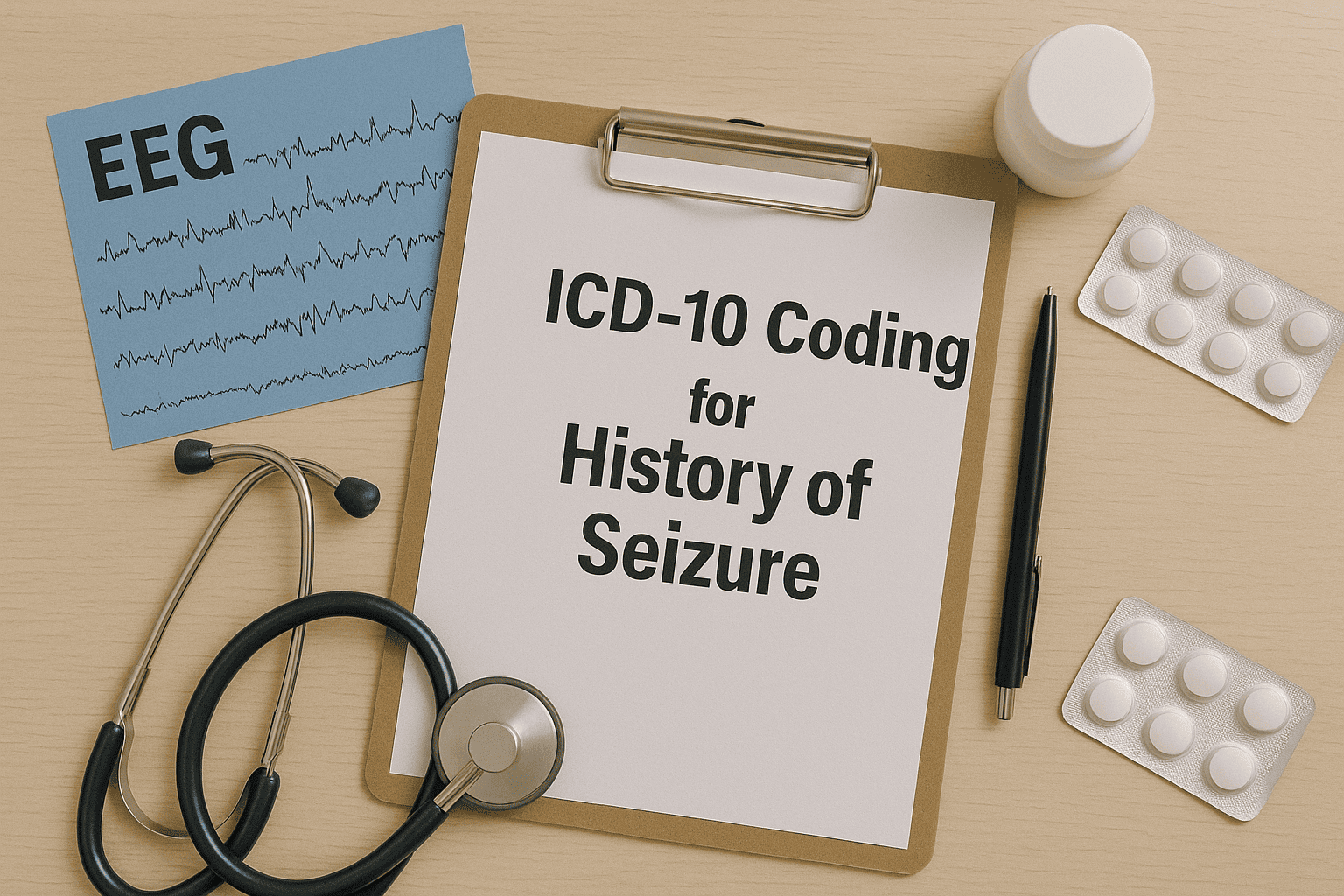Updated on: July 23, 2025
A history of seizure is a critical element in any patient’s medical record—whether you’re managing a child with febrile seizures, an adult with a single episode, or someone with a well-established epilepsy diagnosis. Accurate documentation not only ensures continuity of care but also plays a major role in ICD-10 coding, treatment planning, and medico-legal safety.
In this guide, we’ll explore how to document a patient’s seizure history effectively, when and how to use the right codes, and how DocScrib can help you streamline seizure-related documentation in real time.
🔗 Visit DocScrib.com – The AI scribe that makes neurology documentation smarter and faster.
What Does “History of Seizure” Mean Clinically?
When a provider documents a history of seizure, it can reflect multiple clinical scenarios:
-
A single resolved seizure episode
-
An ongoing epilepsy diagnosis
-
Seizures of unclear etiology pending workup
-
A remote history (e.g., childhood febrile seizure)
Understanding and distinguishing these categories is essential, both for clinical care and ICD-10 classification.
Common Seizure History Presentations
| Clinical Situation | Implication |
|---|---|
| Remote single seizure (resolved) | May not require treatment; document carefully |
| Recurrent seizures | Points to epilepsy; evaluate further |
| Post-stroke or trauma seizure | May be acute symptomatic or unprovoked |
| Medication or alcohol withdrawal seizure | Usually not epilepsy, but should be noted |
| Febrile seizures in childhood | Often benign but worth documenting |
🧠 Clinical Tip: Always ask about seizure triggers, last episode, duration, aura, and post-ictal symptoms. These help guide diagnosis and coding accuracy.
ICD-10 Coding for History of Seizure
Accurate ICD-10 documentation depends on context: whether the patient has resolved seizures, active epilepsy, or a seizure workup in progress.
Common ICD-10 Codes for Seizure History
| Code | Description |
|---|---|
| R56.9 | Unspecified convulsions (use cautiously—non-specific) |
| G40.909 | Epilepsy, unspecified, not intractable, without status epilepticus |
| Z86.69 | Personal history of other diseases of the nervous system (e.g., past seizure) |
| R56.1 | Post-traumatic seizures |
| P90 | Neonatal seizures |
| R56.00 | Febrile convulsions (simple), unspecified |
✅ Use Z86.69 when documenting a seizure history without ongoing epilepsy or active episodes.
❌ Avoid defaulting to R56.9 unless you’re dealing with unclear or undocumented seizure types.
Case Example: Remote History of Seizure
Patient: 33-year-old male presents for a pre-op clearance. States he had one seizure at age 12, no recurrence, no meds.
Traditional Workflow:
-
Manual ICD-10 lookup
-
Vague note in the HPI
-
Missed coding opportunity
DocScrib Workflow:
✅ AI detects:
-
Past resolved seizure
-
No active treatment
-
No recurrence
✅ Suggests ICD-10: Z86.69
✅ Auto-generates SOAP note:
S: Patient reports a single seizure at age 12, diagnosed as febrile. No recurrence since. No medications.
O: No neurological deficits. Normal vitals.
A: Personal history of resolved seizure (Z86.69)
P: No further evaluation required. Cleared for surgery.
📄 Fully EHR-ready. Accurate. Compliant.
When to Use Each ICD-10 Code
| Scenario | Recommended ICD-10 Code |
|---|---|
| Resolved childhood seizure | Z86.69 |
| Active epilepsy, unknown type | G40.909 |
| First-time seizure, pending workup | R56.9 |
| Febrile seizure in child | R56.00 |
| Seizure after trauma or stroke | R56.1 |
| Seizure due to alcohol withdrawal | F10.281 |
Why Seizure History Documentation Matters
| Reason | Impact |
|---|---|
| Medical-Legal Protection | Proves resolved vs. active condition |
| Surgical/Anesthesia Planning | Impacts intraoperative management |
| Coding Accuracy | Drives appropriate billing and claim approvals |
| Care Coordination | Assists neurology, primary care, and pharmacy workflows |
| Risk Stratification | Especially for epilepsy or trauma-related seizures |
DocScrib’s Role in Neurology & Seizure Documentation
DocScrib is your AI-powered medical scribe that listens, understands, and instantly documents complex conditions like seizures and neurological histories with ICD-10 precision.
| Feature | Without DocScrib | With DocScrib |
|---|---|---|
| ICD-10 Code Suggestion | Manual, error-prone | ✅ Real-time, context-aware |
| History of Seizure Detection | May be inconsistently documented | ✅ Automatically highlighted |
| SOAP Note Creation | Manually written | ✅ AI-generated in seconds |
| Pre-op & Specialty Templates | Limited or generic | ✅ Auto-adapted to specialty needs |
| Seizure Type Differentiation | Prone to misclassification | ✅ Based on structured inputs |
🗣️ “I don’t miss seizure history details anymore. DocScrib prompts me with code Z86.69 or G40 series exactly when I need it.” — Hospitalist, New Jersey
FAQs: Seizure History and ICD-10 Documentation
Q1: Should I use Z86.69 for a patient with epilepsy?
No. Use the G40.x series for active epilepsy. Z86.69 is only for resolved, non-active seizure history.
Q2: What if I’m unsure whether the patient’s seizure was provoked or unprovoked?
Use R56.9 as a temporary code and follow up with appropriate diagnostic clarification.
Q3: How often should I update seizure history in the chart?
At every visit. If no episodes since the last visit, note it. This helps with compliance and continuity.
Q4: Can DocScrib recognize complex histories like post-traumatic seizures?
Yes. DocScrib’s neural engine analyzes clinical language and recommends appropriate codes (e.g., R56.1) based on context.
Final Thoughts: Don’t Let Seizure History Go Undocumented
Seizure history might seem like a small line item—but it has big implications for care planning, ICD-10 coding, and clinical decision-making. Whether it’s a resolved childhood event or a newly diagnosed case of epilepsy, documentation matters.
DocScrib helps clinicians:
-
Document seizure histories in seconds
-
Auto-select precise ICD-10 codes like Z86.69
-
Improve charting quality with AI assistance
-
Save time, reduce burnout, and improve billing accuracy
🔗 Learn more at DocScrib.com
📅 Book Your Free Demo Today
